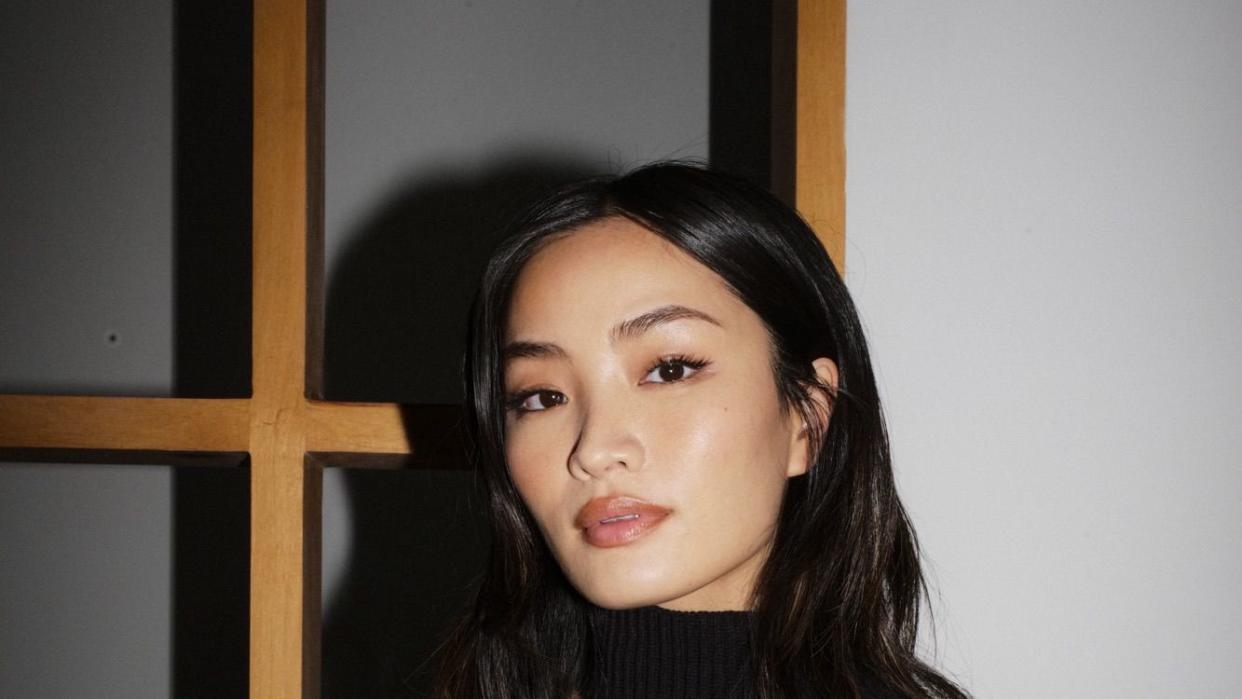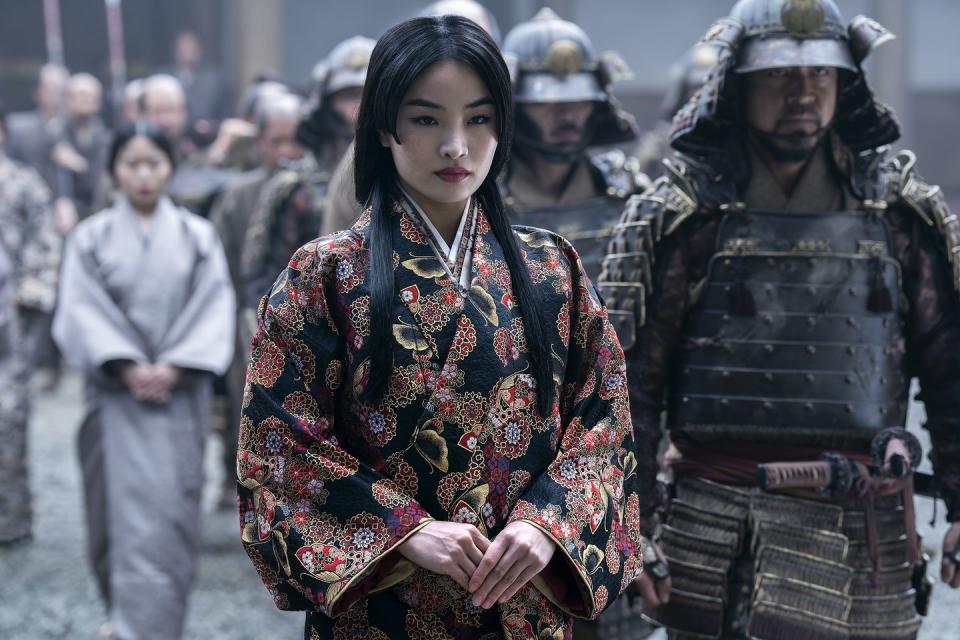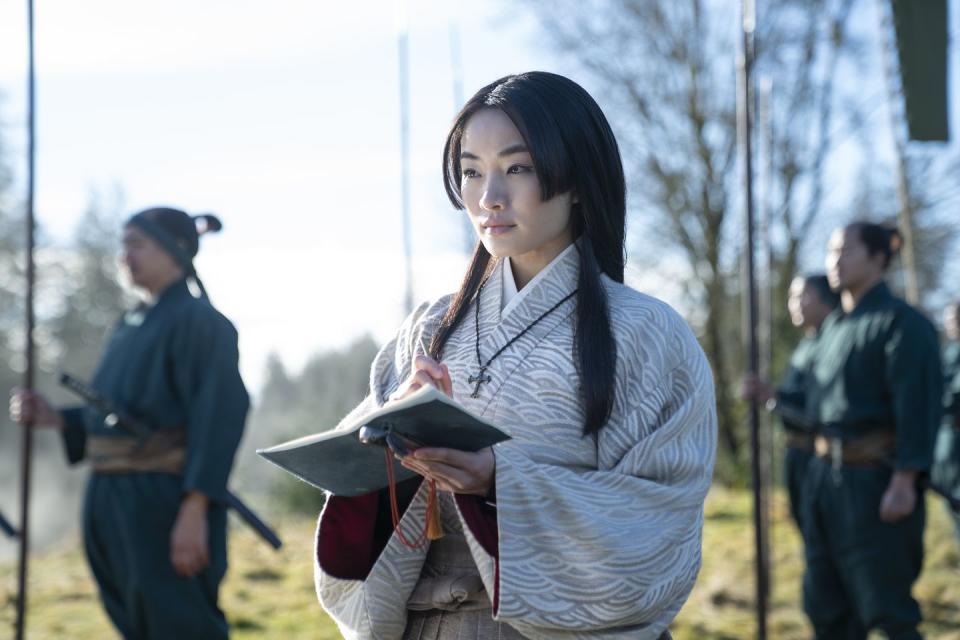The Unforgettable Power of Anna Sawai

- Oops!Something went wrong.Please try again later.
- Oops!Something went wrong.Please try again later.
The following interview contains spoilers for Shōgun episode 9.
When the credits roll on Shōgun’s penultimate episode, Anna Sawai knows exactly what will last in the audience’s mind. “The explosion scene?” she asks. Yes, the explosion scene.
“It felt liberating, to be honest,” Sawai tells me over Zoom, a week before episode 9 aired. “Freeing.” On FX’s Shōgun—the limited series about a power struggle in feudal Japan—Sawai plays a translator named Toda Mariko. Though she’s rarely given a voice of her own, Mariko’s courage erupts in the latest episode. She stands up for herself and fights for what she believes in. In the end, she sacrifices herself for a greater cause: Mariko saves everyone by taking the blunt force of a dynamite explosion, which turns the tide of the war.
“Mariko had her purpose, and she only understood that toward the end,” Sawai says. “Once she did, it really allowed her to just spread her wings and fly. Questioning what you want to do, what you want to achieve, who you want to spend it with.... If Mariko allows you to ask those questions to yourself, that would be pretty nice.”
Shōgun’s Mariko is a breakthrough performance for Sawai. Though she appeared on Monarch: Legacy of Monsters and Pachinko, the FX drama puts her talents on full display. “In the beginning, it was just like, Well, I’m looking for a job,” Sawai says. “I was taping so much in the beginning for, quite frankly, anything. I decided to do [Shōgun] because it stood out as a project for me, as a Japanese woman, feeling like the women in this show were going to be portrayed in a better light.”
Below, Sawai discusses her Shōgun exit, Mariko’s journey, and why she believes a series about feudal Japan is resonating so much with audiences today.

ESQUIRE: This episode is incredibly powerful—Mariko finally stands her ground.
ANNA SAWAI: I really love that part. I love that we get to see all the struggles of the women. Oftentimes, it’s the men that are going to war and the men that have the power. Especially as a Japanese woman, I didn’t see our strength being portrayed in Western media. But in [Shōgun], we really get to see them execute their strength in a completely different way. It’s so quiet and subtle, but they have so much power. I liked that we get to see the different outlets of Mariko’s power. In the naginata scene, it’s obviously a physical strength that she is showing. But in the scene where she’s confronting Ishido, it’s very outspoken. The real strength is within her—and it’s within the actions that she takes. It’s not loud. The most powerful people are the people that don’t really show it.
Did it help knowing that Shōgun was putting more emphasis on its female characters than the 1980 miniseries?
Absolutely. For me, the women are truly the highlight of the show. Knowing where co-creator [Rachel Kondo] was coming from, and that she was going to work very closely with [showrunner] Justin [Marks], made me feel safe. It also felt amazing that Hiroyuki Sanada was going to be producing it as well. Obviously he’s so experienced. It felt like I was in the right hands.
How heavy was the naginata?
They were pretty heavy. We had a rubber one for practice and a wooden one on the day. But I remember having to really, really use my core. I would get sore the next day.
Shōgun filmed in chronological order. Was that helpful on a long production like this, so you could discover things at the same time that Mariko did?
Absolutely. It would’ve turned out quite a mess if we didn’t. The journey that [Mariko] goes through, it’s so up and down. In episode 4, you see her change dramatically because her husband is gone. Then he’s back again and she shuts down. To experience that in order really helped. Otherwise, I would’ve been lost. And then, in the final couple of episodes—and in episode 9—we see her really transform as a person. Without the experience of the first eight episodes, it would’ve looked quite different.
When I spoke to Hiroyuki Sanada last summer, I asked him if there was ever a time when he wanted to correct an American director on something that he considered incorrect or insensitive about Japanese culture. Have you ever found yourself in that position?
On some of them, yeah, I did feel like they were bringing in Japanese stuff that didn’t feel right to me. That could be something like just an object on set—and they can’t read the Japanese, so it’s flipped over. But when it came to something a little bit more creative, like the portrayal of the Japanese or the language, it’s so difficult. When you’re doing a project that’s being translated to Japanese, you can’t get it directly translated, because we speak the language in a very different way. Sometimes I would point things out, and it would be hard to make the adjustment because they already finalized it or the writer just really wanted to use certain words in English. If they don’t speak Japanese, then they won’t understand what we’re trying to get through.
I’ve had those experiences, and that’s why I was afraid that the same thing was going to happen on Shōgun. Luckily, everyone who was part of it was able to respect the culture enough to say, “You know what? I trust you. You can make the changes, because it’s going to make this project better.” You really need that in order to make a show like this.
I’m sure a lot of people watching at home are not aware that you’re speaking more period-authentic Japanese.
It was fun. It’s like Shakespearean English, where you understand it but you don't talk that way anymore. It’s the same kanji, but you read it completely differently. I did have to learn everything. But toward the end, when I would read scripts and it was written in a way that felt a little less Mariko, I would say, “Can we finish the sentence in this way? Because we’ve been doing it that way, and I think that’s her speech now.”

With everything you had to learn for the part—how to properly wear and walk around in a kimono, use a naginata, and ride a horse—did it feel like you were going to Shōgun school?
Yeah, because everything was for this project. Once I booked the role, it really felt like, Okay, I’m going to dedicate the next couple of months to learning how to do everything. I would have my teacher, Kobayashi Akiko-san—who was also my lady-in-waiting—and she would help me wear the kimono. She would tell me everything from just how you shuffle your feet to how much you shuffle them. Really, anything that you can think about, I had to learn from her. Then we had this horse camp, and that’s where I met Kanai Hiroto-kun, who plays Omi, and Kura Yuki-kun, who plays Nagakado. It was literally a Shōgun camp. It was a lot back then, but in hindsight, it’s just fun experiences and memories.
Was there anyone on set who would correct you if you weren’t walking slowly enough or if the etiquette was a bit off?
We had at least three or four people who knew exactly what had to happen. I didn’t trust myself enough to be like, I’m doing it fine. So whenever we were approaching a scene, I would go to them first and be like, “How exactly do I need to do this?” I joke around about it. They would just tell me, “Anna-san, you have to do this. Maybe bow a little lower.” It felt very safe to have multiple people I could go to whenever I did need guidance.
You said in a previous interview that you would hear Cosmo Jarvis screaming in his trailer when he was preparing for his scenes. What was it like to work with him, especially when Blackthorne would go from being this raving maniac to a romantic partner?
Well, I didn’t think that he was going out of his mind. [Laughs.] I knew that was his process to get that very rough voice, because he doesn’t talk in that way. I respected him, if anything, because he’s going that far. It was nice that—like how we were talking about shooting it chronologically—I got to know Cosmo as Mariko got to know Blackthorne, and I think it does show. We had very long days on set, so that was mainly where we really got to bond. He’s so dedicated, and seeing all that made me really appreciate him as well.
Did Hiroyuki Sanada leave you with any advice once filming wrapped?
I feel like everything that comes out of his mouth is wise words. We’ve had so many good conversations, and some of them I would like to keep private. But when I was struggling in a scene—or I felt like I wasn’t showing enough because Mariko is not allowed to show it, even though as an actor, you want to show your emotions—he told me, “That’s exactly what the character’s going through, so just let it be. Don’t try to force anything that’s not coming out. The more that you try to conceal it, the more interesting it might be.” I’ve learned from that, and I try not to push too hard if it doesn’t feel right.
Why do you think a show about feudal Japan is really connecting with people right now?
It’s so educational. We really get to understand where Japanese people are coming from, what their history was like. It’s nothing like that right now. No one’s walking around with a sword, but it still teaches us the roots, so I’m so happy. It’s very relative, because it’s talking about politics, human relations, and understanding different cultures—things that you don’t agree with but have to accept. You can come from anywhere and still be able to relate to that. It’s fascinating.
You Might Also Like

